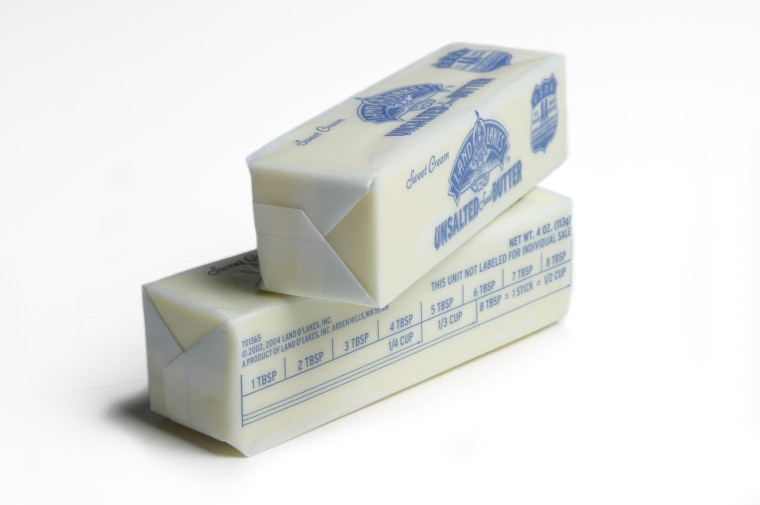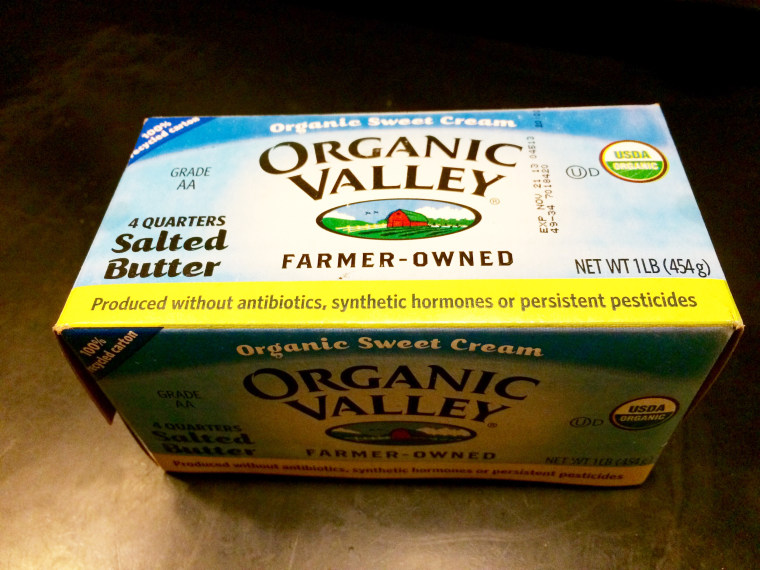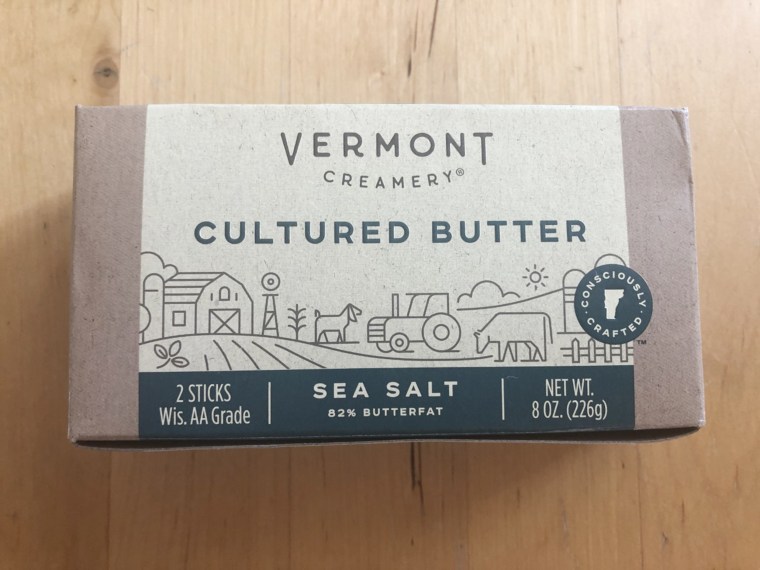Let's face it: Most things in life taste better with butter. We know Julia Child would agree!
But which butter is best for baking, cooking or just smothering on toast? To get well acquainted with this creamy condiment, its uses and how to store it (because stocking up on groceries is on everybody's minds right now), TODAY Food spoke with chef Kathryn Gordon, a pastry and baking instructor at the Institute of Culinary Education. When it comes to butter, Gordon knows best.
According to Gordon, one of the things that makes butter so great (and a true staple for every kitchen) is that it can be bought in bulk. Butter retains its flavor and texture even after being frozen for up to a year.
When butter isn't frozen, does it need to stay refrigerated or can it remain at room temperature on the kitchen counter?
While it's safe to let butter soften outside the fridge for a few hours, keeping it out and exposed to air will make it go rancid faster, said Gordon. For that reason, when you're not using butter, it's best to keep it in the fridge.
Now that we've mastered the basics of butter storage, here's what all home cooks should know about the different varieties, what makes them distinct and how to use them.
Unsalted butter

"If you ask someone why chefs like to use unsalted butter versus salted, you typically get an answer that it’s easiest to control the salt in a dish using unsalted butter," Gordon said.
That's why most recipes, particularly ones that require baking, call for unsalted butter. This type of butter is 36% to 40% butterfat and is made from the fat that separates from fresh heavy cream. After it's churned, the leftover liquid becomes what we know as buttermilk. Typically, unsalted butter costs about $3 to $6 per pound, depending on whether it's organic.
Salted butter

Salted butter is made the exact same way as the unsalted variety, but, not surprisingly, it incorporates salt into the mix. If you want your butter to last longer (and enjoy salt), this is the butter for you.
"If you buy your favorite brand of butter, salted and unsalted, both the same expiration date and you 'hide' the butter in your refrigerator until that expiration date has past, you will taste the rancidity in the unsalted butter, but the salted butter may disguise the rancid taste," Gordon told TODAY.
Salted butter is great for spreading on breads, pastries and even vegetables. Gordon recommends taking a little salted butter (or making your own with unsalted butter topped with sea salt crystals) and spreading it on radishes in the spring. It's a classic French snack.
Salted butter retails between $3-$6 per pound.
Grass-fed butter
No, this type of butter doesn't have any grass in it. Typically a little more expensive than other butters, this type of butter is made solely with dairy from grass-fed cows that are raised in pastures and consume a grain-free diet.
Due to how the cows are raised, these butters typically cost a little more (depending on the brand, around $4 for a half pound), but Gordon said it works very well for baking, roasting and stovetop cooking.
European and European-style butter
European butter has a lower water content and a higher fat content, so it has a very rich taste. Real imported butters from Ireland, Denmark or France are more expensive, but many U.S. manufacturers now produce European-style butters, which cost a little less than their foreign-made counterparts.
"European (and European-style) butters are all easier to 'cube' for a recipe than a brittle, high water content butter and therefore are preferred by busy bakers," Gordon told TODAY. "They are also better for baking because water activates gluten in a wheat-based dough — and when you don’t want gluten, the additional fat in the European-style butter helps buffer and prevent the development of that gluten."
European butters, like Kerrygold and Plugra, retail for about $5-$6 for 8 ounces.
Cultured butter

The cream in cultured butter is fermented a few days before the butter is churned. This also converts the natural sugars (lactose) to lactic acid.
"Fermentation improves flavor, so there is more depth and maybe a bit of tanginess in these butters When you want more complexity in a dish, a cultured butter provides a good base," Gordon said.
This type of butter is also on the pricier side; depending on the brand, 8 ounces will set you back $4.
Whipped butter
Whipped butter, which is sold in containers rather than sticks, undergoes a commercial process which, quite literally, whips in a bunch of air to make it softer. This type of butter is spreadable when cold, so it's a nice butter to have on hand if you eat a lot of toast and don't have a lot of patience.
It's also less caloric. According to Gordon, there are fewer calories per tablespoon (not by weight) in whipper butter due to its airy nature.
"You can make your own whipped butter if you soften butter and put it in a mixer and whip air into it. And you can also flavor it that way with maple syrup, honey or some berries to make a nice brunch spread," Gordon said.
Ghee

Ghee, a clarified butter that's lactose-free, has skyrocketed in popularity, thanks in large part to higher-fat diet plans, like keto, and lactose-free lifestyles, like paleo. Ghee works as a substitute for regular butter in a lot of recipes. Clarified butter is butter made from grass-fed cows. When it's heated, the milk solids are removed, leaving behind a lactose-free product with a similarly rich, yet slightly nutty flavor.
Ghee can be used in the same way you'd use butter, especially for stovetop cooking, or most types of oil. You can warm it in a pan and use it to sauté your favorite vegetables. You can also melt it down and use it for baking to replace the same amount of melted butter or oil. The smoke point of ghee is also higher than butter (about 465 degrees versus 350 degrees for traditional butter), so it works well when making dishes like grilled cheese or French toast, or any other dish where you don't an unwanted smoky flavor in the final product.
Compound butter
Compound butter comes in many different flavors and involves mixing any kind of softened or whipped butter with different seasonings, herbs, sweeteners or other flavoring agents.
"A typical (compound butter) for steak is a lemon-herb butter with some lemon juice and zest, and finely minced parsley," Gordon recommended. "In my family we make one for the traditional zuppa di pesce on Christmas Eve with tarragon, parsley, oregano, thyme, rosemary, sage, extra virgin olive oil, garlic, salt and pepper as well as the lemon, and it is delicious spread on toasted bread."
Compound butters can be bought pre-made (you'll often find them in the cheese or deli section of a supermarket). Prices will vary depending on the ingredients used, but it will usually be more expensive than totally plain butter.
Goat and sheep milk butter
These butters are delicious alternatives to butter made with cow's milk, and they're also a good option for people with lactose sensitivities. However, if you love traditional butter, you'll certainly taste the difference here and these aren't recommended for baking, unless a recipe specifically calls for something unique.
Goat milk butter has the same tangy and earthy notes as goat cheese. Sheep's milk is a little less tangy, but definitely has more grassy, vegetal notes than traditional cow's milk. Unless you know a goat farmer, these butters will typically cost about $2-$3 more per pound than regular salted or unsalted butter because they're not as widely available and still made in relatively small batches.
"In general, many people find sheep's milk butter more neutral in taste," Gordon said. "Some people love it, some don’t."


